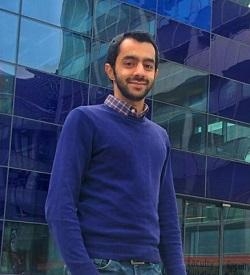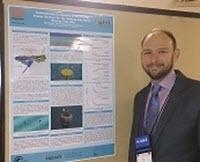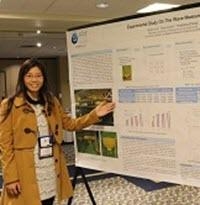2014 Post Award Winners
 First prize (€1,500)
First prize (€1,500)
Amin Abolghasemi
For the study:
Simulating tidal turbines with adaptive meshes and RANS turbulence models
Abstract
A versatile numerical model for the simulation of flow past horizontal axis tidal turbines has been developed. Most large-scale models use the shallow water equations and therefore can fail to account for important turbulent physics. The current model is based on actuator disc momentum (ADM) theory, uses a RANS model to account for turbulence and utilises dynamic mesh adaptivity. The same ADM implementation has been carried out in OpenFOAM allowing for a comparison between the two numerical models. Furthermore, a series of laboratory experiments were carried out in the hydrodynamics laboratory of the Civil Engineering Department at Imperial College London which were used to help validate the numerical model. This model has been developed with the aim that it will be coupled with and embedded within larger numerical models simulating tidal flows in realistic domains, e.g. the Inner Sound of the Pentland Firth. This is where the adaptive meshing capability is a major advantage as it enables the mesh to be refined only in the locations required, thus making optimal use of finite computational resources. The resulting capability will be used for resource optimisation and to assess environmental impacts.
CV Description: PhD student at Imperial College London researching tidal turbine array design, focusing on the Inner Sound of the Pentland Firth, in collaboration with MeyGen Ltd. Amin has an MEng in Engineering from Cambridge University.
Download Poster
 Second prize (€1,000)
Second prize (€1,000)
Bret Bosma
For the study:
Performance Evaluation of a Floating Power System for the Galway Bay Wave Energy Test Site
Abstract
Numerical modeling and scaled physical modeling of the Galway Bay Wave Energy test site were the main outcomes of the research. Proposed infrastructure for the site includes a floating power system to act as a power and data acquisition platform as well as a local grid connection. The modeling done for this research included this floating power system as well as a generic oscillation water column type wave energy converter. Numerical analysis was performed using Ansys Aqwa, and physical modeling testing was performed at 1:25 scale at the National Ocean Energy Test Facility at University College Cork, Ireland. Results of the research include characterizing the expected response of the full scale bodies as well as informing future testing to be done at 1:10 scale. This work will ultimately influence the final implementation of the Galway Bay Wave Energy test site.
CV Description: Bret is currently in the middle of a two year postdoc funded by the United States Department of Energy (USDOE) Energy Efficiency and Renewable Energy (EERE). The first year of the postdoc was in Cork, Ireland at University College Cork (UCC). The second year is in Corvallis, Oregon USA at Oregon State University working with the Northwest National Marine Renewable Energy Center (NNMREC). Bret graduated with a PhD in Electrical Engineering from Oregon State University in 2013 with a dissertation entitled “On the Design, Modeling, and Testing of Ocean Wave Energy Converters”. Bret also graduated with bachelor and master degrees from California State University, Chico in Electrical Engineering in 2005 and 2008 respectively.
Download Poster
 Third prize (€ 500)
Third prize (€ 500)
Qiuin Liu
For the study:
Experimental Study On The Wave Measurements Of Wave Buoys
Abstract
Wave measurement is of vital importance for assessing the wave power resources and for developing wave energy devices, especially for the wave energy production and the survivability of the wave energy device. Wave buoys are one of the most popular measuring technologies developed and used for long-term wave measurements. In order to figure out whether the wave characteristics can be recorded by using the wave buoys accurately, an experimental study was carried out on the performance of three wave buoy models, viz two Wavescan buoys and one ODAS buoy, in a wave tank using the European FP7 MARINET facilities. This paper presents the test results in both time and frequency domains and the comparison between the wave buoys and wave gauge measurements. The analysis results reveal that for both regular and irregular waves, the Wavescan buoys have better performances than the ODAS buoy in terms of accuracy and the Wavescan buoys measurements have a very good correlation with those from the wave gauges.
CV Description: Qiulin completed a bachelor major in Hydraulic Engineering in Tsinghua University, July 2011 and initiated a doctoral study focusing on renewable marine energy, especially wave energy. In 2013, Qiulin has done a 6-months internship at Hydraulic & Maritime Research Center (HMRC), University College Cork, Ireland.
Download Poster


 First prize (€1,500)
First prize (€1,500) Second prize (€1,000)
Second prize (€1,000) Third prize (€ 500)
Third prize (€ 500)